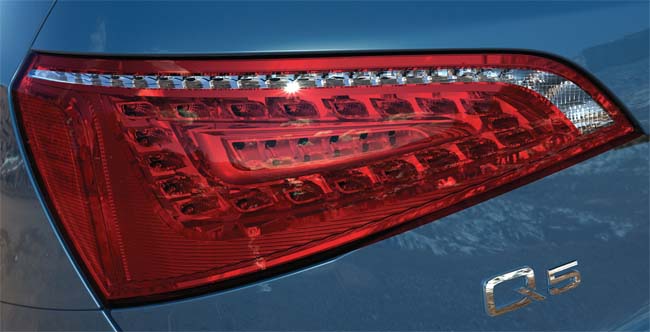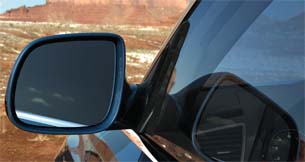Latest News
January 3, 2010
By Shawn Hempel
Designing products that are safer, more aerodynamic and ultimately attractive is paramount for companies like adidas, Audi, Porsche, and Airbus. One increasingly popular product design trend that these companies are using is virtual prototyping.
 Real-time raytracing has quickly gained recognition for its value in the design areas of lights and panes, making it particularly useful in designing complex tail lights and analyzing window reflections. |
Virtual prototypes allow designers to evaluate every inch of a product, starting by converting original computer-aided design (CAD) data into usable, photorealistic models that can be manipulated in real time. With virtual prototyping, designers can instantaneously view different configurations, thereby reducing the need for expensive physical prototypes and streamlining the design and production process, all while giving them greater design flexibility and saving companies millions of dollars.
The challenge? With virtual prototyping, a high degree of realism and visual quality are crucial.
Visualization is by nature an estimation of reality, albeit with today’s technology, a very convincingly realistic one. In contrast, simulation is a physically correct representation of reality. In the absence of physical prototypes, designers require precise simulation, consistent and repeatable physical-based model rendering, the ability to easily modify light and materials, and the option of switching between design alternatives for effective comparison.
 RTT RealTrace enables physically correct simulation of light refracting and reflecting in real time, even for dynamic 3D scenes. Here you see light and shadows displayed in real time and with considerable accuracy. Note the shadows cast by the side mirror and the reflections shown on the door. |
Ray tracing is undoubtedly one of the most realistic methods of rendering images created in 3D computer environments. Ray tracing tools allow reflections, refractions, and the absorption behavior of surface materials to be simulated precisely, making this technique essential in the powerful and realistic representation of 3D models. However, ray-tracing calculations are considered to be extremely time-consuming, and until now it has taken users hours to process ray tracing effects of a single image.
The main principle of ray tracing is based on the lengthy backward tracing of rays—starting from the eye of the viewer through each pixel of the image until it hits a part of the scene intended to be displayed. The pixel contains both the color and intensity of the surface element it has hit. From a scientific viewpoint, it’s a technical challenge to simulate the accurate distribution of rays.
Munich-based virtual reality specialist RTT AG has revolutionized the market and provided a solution to previous ray-tracing challenges with its pioneering module, RTT RealTrace. RTT RealTrace is a component of RTT DeltaGen 9.0, a design and engineering software application that allows designers to build hyper-realistic 3D models and interact with those models in real time. RTT RealTrace is the world’s first real-time raytracer, producing physically correct simulation of light refracting and reflecting in real time, even for dynamic 3D scenes.
With RTT RealTrace, designers now benefit from a technology that visualizes global illumination effects rapidly, allows for changes anytime during the presentation, and eliminates long preparation and pre-calculation steps. RTT RealTrace enables exact visualization of materials, including complex effects and surface structures.
RTT RealTrace is based on the NVIDIA Quadro technology and enables real time, interactive visualization and analysis of digital models. It is fully integrated, runs on a desktop machine, and can run on an NVIDIA Quadro cluster. RTT RealTrace is 10 times faster than existing CPU-based products.
This new technology allows physically accurate reflections, refractions, and absorption behavior of surface materials to be calculated and displayed in real time. In addition, RTT RealTrace enables a smooth integration into OpenGL, allowing the user to ray trace only specific parts. Through full integration, designers can use existing virtual models and hardware setups, which allows for a high degree of usability and workflow flexibility.
“The combination of RTT DeltaGen 9.0 with the NVIDIA Quadro platform gives our customers the best visualization and performance available,” explained Ludwig Fuchs, RTT co-founder and board member. “Together, we are challenging reality with unprecedented 3D visual quality. The NVIDIA Quadro solutions ultimately allow us to offer our customers flexibility, which in turn saves them time and money.”
“The breakthrough is in its ability to address speed like never before,” Fuchs added.
The unique advantage of RTT RealTrace is speed, which remains most critical to virtual reality users and designers. The result of RTT RealTrace and NVIDIA Quadro platform is high-end simulation in real time. This allows designers to rebuild virtual prototypes every night whereas competitors’ software would take several days. The ability to compress the product development timeline has unmatched value.
RTT’s is the only technology solution that uses new software techniques like meta programming on the GPU instead of the CPU. The tool generates more than convincing results with a single high-end NVIDIA Quadro solution. To add flexibility, RTT RealTrace is cluster-compatible and optimally distributes the data via dynamic load balancing.
RTT RealTrace and NVIDIA Quadro solutions provide the flexibility of changing the look and materials while modifying light sources. Since the calculation algorithms of RTT RealTrace are based on real optical facts, the visualization is physically accurate. The effect is that designers see exactly how light will travel—not an approximation thereof. RTT RealTrace provides insight into dysfunctions caused by lighting, such as when glare from dashboard material, due to its angle onto the windscreen, impairs viewing. The advantage of a virtual prototype enhanced with RTT RealTrace is that dysfunctions are identified early in the process, not after a company spends millions to build a physical prototype.
Real time ray tracing has quickly gained recognition for its value, particularly in the design areas of lights and panes, making it particularly useful in designing headlamps and analyzing windhshield reflections. Customers like Porsche, Airbus, Audi, Volkswagen, BMW, and General Motors have taken advantage of RTT RealTrace. In reference to tolerance analysis, it is crucial to interactively visualize global illumination effects, such as specular and glossy refraction and reflection, ambient occlusion, hard and soft shadows, indirect illumination, color bleeding, or light emitting objects. Doing so, designers can now discover problematic reflections earlier and adjust design aspects more effectively due to RTT RealTrace’s ability to portray an accurate reflection in the panes. Even complex headlights, where accurate representation caused significant problems in the past, can now be visualized easily and correctly to provide a reliable impression of the final product.
The visual computing power of NVIDIA Quadro’s graphics solutions provides cost-saving solutions and enables RTT’s customers to affordably integrate visual prototyping into all areas of design, where it was previously cost-prohibitive. Not only are subtle design details easier to assess, but RTT DeltaGen 9.0 powered by the NVIDIA Quadro platform is shortening a product’s time-to-market. From cars to aircraft, new products designed with these two technologies incorporate better ergonomics, higher safety standards and superior design aesthetics.
With continuous improvements in hardware performance, even the most complex designs can be interactively visualized in the future. Phenomena that today cannot be visualized in real time—such as dispersion, diffuse reflections, refractions, and caustics—will soon be a standard request.
More Info:
NVIDIA
Shawn Hempel, director of research and development, joined RTT USA in 2008 and is responsible for all R&D activities in North America. Hempel has led RTT’s real-time raytracing and lighting technology advancements. To comment, send e-mail to [email protected].
Subscribe to our FREE magazine, FREE email newsletters or both!
Latest News
About the Author
DE’s editors contribute news and new product announcements to Digital Engineering.
Press releases may be sent to them via [email protected].






